All cats possess a certain mystique, but there’s an undeniable allure to calico cats, especially those with luxurious long hair. These felines captivate with their unique tri-colored coats and often fluffy appearance, sparking curiosity about their origins, traits, and care. You might have wondered, are long-haired calico cats always female? What breeds are most likely to sport this striking pattern in a long-haired variety? Delve into the fascinating world of long-haired calico cats and uncover captivating facts about these beautiful creatures.
Calico: A Coat of Many Colors, Not a Breed
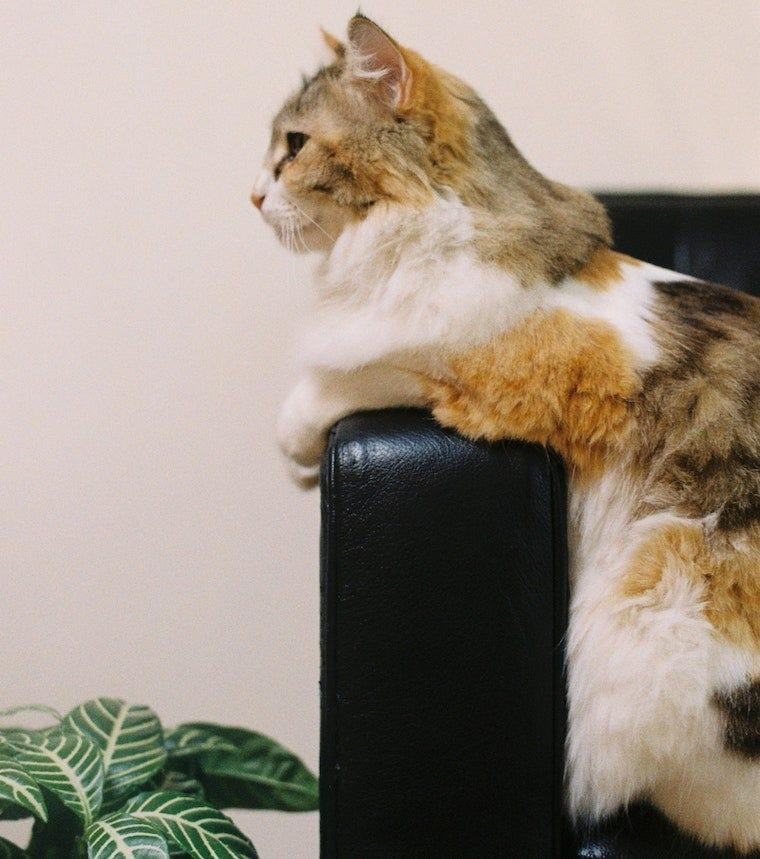 long-haired calico cat sitting on a black couch arm
long-haired calico cat sitting on a black couch arm
Photo of a long-haired calico cat gracefully perched on a black couch arm, showcasing its tri-colored fur.
Just like the term “tabby” describes a coat pattern rather than a specific breed, “calico” refers to the distinctive tri-color pattern seen in some cats. This pattern isn’t exclusive to any single breed and can appear in both short-haired and long-haired cats. The classic calico displays patches of white, black, and orange, but variations can include softer shades like cream, reddish-brown, and grey-blue, creating a diverse palette of calico beauty. Therefore, when we talk about a long-haired calico cat, we’re describing a cat with a long coat that also exhibits the calico coloration.
The name “calico” is believed to originate from calico cloth, a vibrant printed cotton that was once imported from India to England, as noted by Spruce Pets. While the name’s origin is tied to textiles, the history of the calico pattern in cats is rooted in genetics and geographical distribution. Research, as highlighted in Sue Hubbel’s Shrinking the Cat: Genetic Engineering Before We Knew About Genes, suggests that the genetic mutation responsible for the orange color in calicoes can be traced back to port cities along the Mediterranean, including those in Greece, France, Spain, and Italy, with roots possibly extending to Egypt. This fascinating history underscores the global journey of this striking feline trait.
The Gender Factor: Are Long Haired Calico Cats Always Female?
 Calico cat facts
Calico cat facts
Image showcasing calico cat facts, emphasizing the genetic link to gender and coloration.
Among the most intriguing calico cat facts is the strong correlation between the calico pattern and gender. It might sound like folklore, but it’s scientifically accurate: almost all long-haired calico cats, and calico cats in general, are female. This phenomenon is directly linked to the X chromosome and the genetics of color expression in cats. The tri-color calico coat requires the presence of two X chromosomes. Female cats inherit two X chromosomes (XX), while males inherit one X and one Y chromosome (XY).
The genetic code for orange and black coat colors resides on the X chromosome. To display both black and orange fur, a cat needs to inherit two X chromosomes, one carrying the gene for orange fur and the other for black fur. The white patches, a hallmark of the calico pattern, are determined by a separate gene, not linked to the sex chromosomes, which essentially masks the color in certain areas, allowing the distinct patches to appear. This intricate genetic dance results in the beautiful and complex coat we admire in long-haired calico cats, and it’s inherently tied to them being female.
The Rare Male Long Haired Calico Cat
While incredibly rare, male long-haired calico cats do exist, but they are an exception to the rule. Approximately 1 in every 3,000 calico cats is male. These males typically possess an extra X chromosome, resulting in an XXY chromosomal makeup, a condition known as Klinefelter’s Syndrome. Unfortunately, these male calico cats are almost always sterile and are prone to various health issues due to their genetic abnormality, according to the ASPCA.
Health concerns associated with Klinefelter’s Syndrome in male calico cats can include cognitive and developmental delays potentially leading to behavioral problems, decreased bone density increasing fracture risk, and a predisposition to obesity and related medical conditions.
In even rarer scenarios, a male long-haired calico cat can be a “feline chimera.” This occurs when two embryos fuse in the womb, creating a single animal with two distinct sets of DNA. Interestingly, unlike XXY males, chimeric male calico cats can sometimes be fertile, though this is still uncommon. Regardless of fertility, it’s always recommended to neuter any male cat, including a rare male long-haired calico, for health and behavioral reasons.
Calico vs. Tortoiseshell: Understanding the Difference in Long Haired Cats
It’s easy to confuse calico and tortoiseshell (tortie) patterns, especially in long-haired cats where the colors can blend beautifully. However, they are distinct coat patterns. The key differentiator is the presence of white patches in calico cats. Tortoiseshell cats, on the other hand, primarily exhibit a mix of black and orange hues, often appearing swirled or brindled together, with little to no white. In regions outside of North America, calico cats are often referred to as “tortoiseshell-and-white,” highlighting this distinction.
When you combine the tabby pattern with either tortoiseshell or calico, you get “torbie” and “caliby” cats, respectively. A “torbie” long-haired cat will display a mix of brown and orange tabby patterns intermingled with tortoiseshell coloring, while a “caliby” will have tabby markings alongside the classic calico patches. These combinations can result in stunning variations within long-haired cats.
Long Haired Cat Breeds Predisposed to Calico Patterns
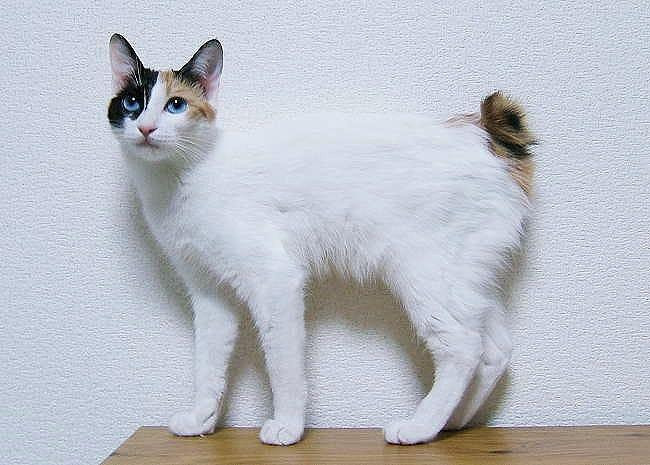 Japanese Bobtail calico cat
Japanese Bobtail calico cat
Image of a Japanese Bobtail calico cat, illustrating a breed commonly associated with the calico pattern.
While calico isn’t a breed itself, and breeding specifically for calico coloration is not possible due to its genetic randomness, certain long-haired cat breeds are more frequently seen with the calico pattern. It’s important to remember that even within these breeds, calico is just one of many possible coat colors.
Long-haired breeds that are known to sometimes exhibit the calico pattern include:
- Maine Coon: These gentle giants, known for their impressive size and shaggy coats, can occasionally sport the calico pattern. A long-haired calico Maine Coon is a truly striking cat.
- Persian: With their luxurious, flowing coats, Persian cats can also come in calico. The calico pattern on a long-haired Persian creates a vision of elegance and fluffiness.
- Turkish Angora: These graceful and silky-coated cats are another breed where calico coloration can appear, enhancing their ethereal beauty.
- Norwegian Forest Cat: Similar to Maine Coons, Norwegian Forest Cats are robust, long-haired breeds that can sometimes be calico, adding to their wild and charming appearance.
- Himalayan: A mix of Persian and Siamese, Himalayans are long-haired and can inherit the calico pattern, often with pointed coloration, creating a unique look.
While these breeds are more likely to be calico in their long-haired variations, it’s crucial to remember that coat color is still a matter of genetic chance.
Personality Traits in Long Haired Calico Cats: Breed Matters More Than Color
Coat color, including the calico pattern, does not dictate personality in cats. However, breed characteristics do play a significant role in shaping a cat’s temperament. Therefore, a long-haired calico cat’s personality will be more influenced by its breed than its coloration.
For instance, if your long-haired calico is a Persian, you can expect a generally calm and docile companion, perhaps even a bit lazy, as Persians are known for their relaxed nature. A long-haired calico Maine Coon might be more playful and outgoing, reflecting the breed’s friendly and adaptable personality. If you have a long-haired calico Turkish Angora, you might find them to be intelligent, curious, and active.
To understand the personality of your long-haired calico cat, it’s best to research the typical traits of the breed they most resemble. While every cat is an individual, breed tendencies offer valuable insights into their potential temperament.
Calico Cats as Cultural Icons: From Figurines to Political Figures
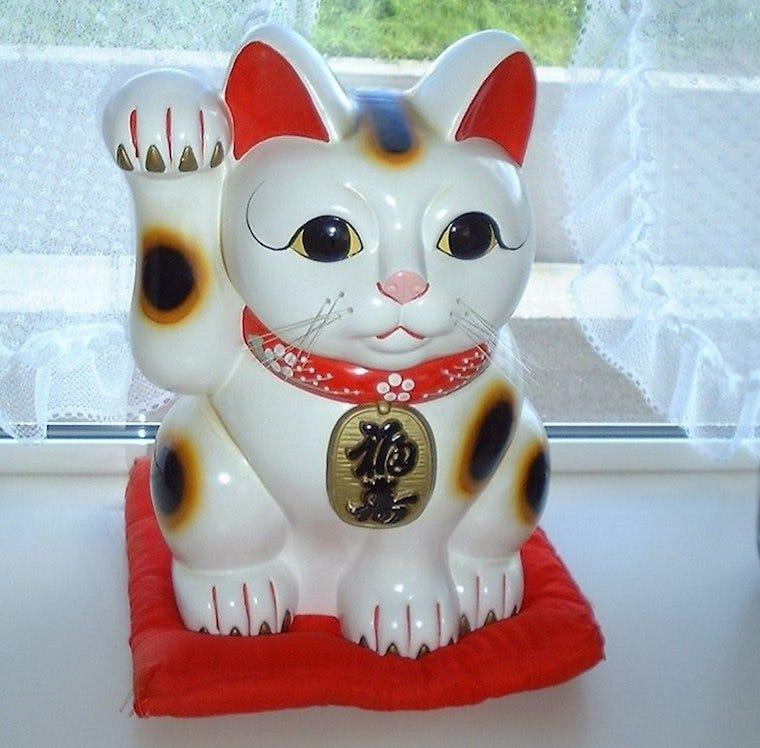 Maneki Neko calico cat figurine
Maneki Neko calico cat figurine
Image of a traditional calico Maneki Neko figurine, a symbol of good luck and fortune.
Calico cats have transcended the pet world and become cultural symbols in various societies. One of the most famous examples is the Maneki Neko, or “lucky cat” figurine. This ubiquitous charm, often seen in businesses and homes, is traditionally depicted as a seated calico Japanese Bobtail cat with a raised paw, beckoning good fortune, wealth, and prosperity. The Maneki Neko’s enduring popularity highlights the calico cat’s association with luck and good tidings.
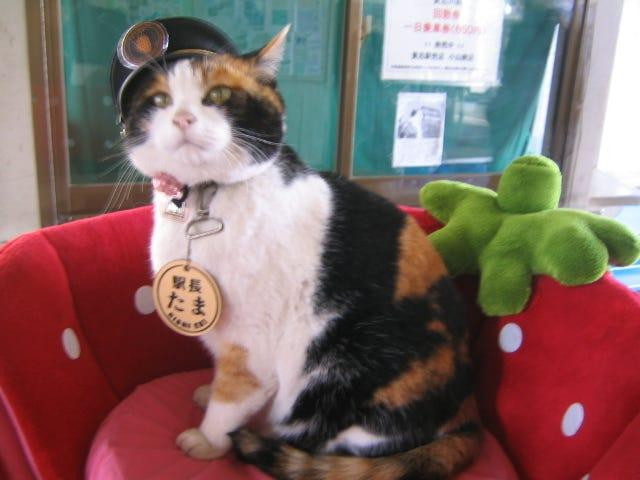 Station-Master_Tama.jpeg
Station-Master_Tama.jpeg
Image of Tama, the calico cat station master, showcasing her uniform and official role.
In Japan, a calico cat named Tama achieved national fame as the station master of Kishi Station. Appointed in 2007, Tama’s role was to greet passengers, and her presence significantly boosted the local economy. Tama was provided with food, a name tag, and a custom station master hat. Her legacy as a beloved and hardworking calico cat station master continues even after her passing in 2015.
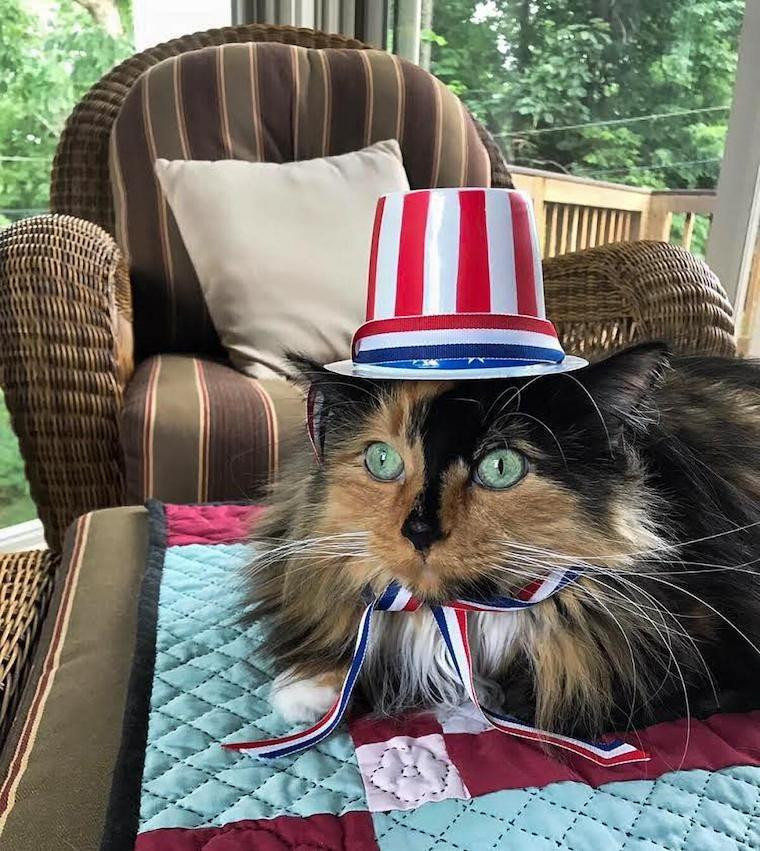 sweet-tart.jpeg
sweet-tart.jpeg
Image of Sweet Tart, the calico cat mayor, representing the lighter side of calico cat fame.
Across the globe in Omena, Michigan, a calico cat named Sweet Tart was “elected” mayor in 2018. While a ceremonial role, Sweet Tart’s election raised thousands of dollars for the town’s historical society, demonstrating the calico cat’s ability to capture hearts and contribute to communities.
Beyond specific examples, calico cats are generally considered lucky in many cultures. In the United States, they are sometimes called “money cats” due to their association with good fortune. Japanese fishermen historically brought calico cats on ships for protection against storms and bad luck. Irish folklore even suggests that rubbing a calico cat’s tail on a wart in May can cure it (though this is not a medically advised remedy!).
Finally, the calico cat is the official state cat of Maryland, adopted in 2001. This designation was chosen because the calico’s colors—orange, black, and white—mirror the colors of Maryland’s state bird, the Baltimore oriole, and state insect, the Baltimore Checkerspot butterfly, making it a purrfectly symbolic choice.
Caring for Your Long Haired Calico Cat: Grooming and Love
Caring for a long-haired calico cat involves the same essentials as caring for any cat: providing a nutritious diet, fresh water, a clean litter box, regular veterinary checkups, and plenty of love and attention. However, their long fur does require specific grooming attention.
Regular brushing is crucial for long-haired calico cats to prevent mats and tangles. Daily brushing is ideal, but even a few times a week can make a significant difference. This not only keeps their coat healthy and beautiful but also helps reduce shedding and hairballs. Depending on the breed and coat type, occasional baths may also be necessary.
Beyond grooming, long-haired calico cats thrive on interaction and play. Provide them with scratching posts, toys, and opportunities for enrichment to keep them physically and mentally stimulated. Like all cats, they appreciate a safe and comfortable environment where they feel loved and secure.
Choosing a Name for Your Long Haired Calico Cat
If you’re welcoming a long-haired calico cat into your home, choosing a name that suits their striking appearance can be fun. “Callie” is a classic and popular choice for calico cats. Other name ideas that celebrate their unique coloration include:
- Patches
- Cleopatra (for a regal calico)
- Snickers
- Amaretto
- Camo
- Oriole
- Motley
- Picasso
- Spice
You can also draw inspiration from their breed or personality when selecting a name.
Long Haired Calico Cats on the Silver Screen
Calico cats, including long-haired varieties, have made appearances in various movies, often adding a touch of feline charm to the scenes. While not always main characters, their cameos are always a delight for cat lovers. Some movies featuring calico cats include:
- Soul (2020)
- Venom (2018)
- Isle of Dogs (2018)
- Second Act (2018)
- The Shape of Water (2017)
- Kedi (2016)
- Regression (2015)
- The Nine Lives of Christmas (2014)
- The Good Heart (2009)
- Corky Romano (2001)
- While You Were Sleeping (1995)
- Grumpy Old Men (1993)
- L.A. Story (1991)
- The Package (1989)
- Like Father, Like Son (1987)
- Saint Jack (1979)
- Midnight Express (1978)
- The Fury (1978)
Keep an eye out for these beautiful felines in your next movie night!
Conclusion: Embracing the Magic of Long Haired Calico Cats
Long-haired calico cats are truly special felines, combining a captivating coat pattern with the added luxury of long, flowing fur. While the calico pattern itself is not a breed, it appears in various long-haired breeds, each with its unique personality and charm. The near-exclusive female gender of calico cats adds to their mystique, as do the cultural associations with luck and good fortune. Whether you’re already a proud owner or simply an admirer, the world of long-haired calico cats is full of fascinating facts and undeniable beauty. If you’re seeking a beautiful, and potentially lucky, feline companion, consider the enchanting long-haired calico cat.
Are long haired calico cats always female? Almost always. The genetic makeup required for the tri-color calico coat is intrinsically linked to having two X chromosomes, which biologically defines a female cat.
Embrace a better life with cats with a self-cleaning litter box.
Cover photo by Erika on Unsplash
[

